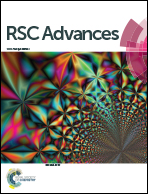Preparation of cubane-1,4-dicarboxylate–Zn–Al layered double hydroxide nanohybrid: comparison of structural and optical properties between experimental and calculated results†
Abstract
In the present research, we report cubane-1,4-dicarboxylate anions (cuban-dc) assembled into a Zn2Al layered double hydroxide (LDH) inorganic host using the coprecipitation method, in which solutions of Zn(II) and Al(III) nitrate salts react with an alkaline solution of cubane-1,4-dicarboxylic acid. Powder X-ray diffraction, FTIR spectroscopy, elemental analyses, and thermal gravimetric analysis (TGA) were used to characterize the successful incorporation of the cubane-1,4-dicarboxylate anions into the interlayer space of LDH. Periodic density functional theory was employed to understand the structural and electronic properties of the cubane-dc–Zn2Al-LDH system. The quantum mechanics study was supported by periodic density functional theory (DFT) calculation which predicts appropriate values for structural and optical properties of cubane-dc–Zn2Al-LDH. Optical and structural theoretical results are in good agreement with the experimental results, which show that when cubane-1,4-dicarboxylate anions intercalate in Zn–Al-LDH, they cause a red shift and subsequently decrease the band gap energy in comparison with LDHs that contain small anions.


 Please wait while we load your content...
Please wait while we load your content...